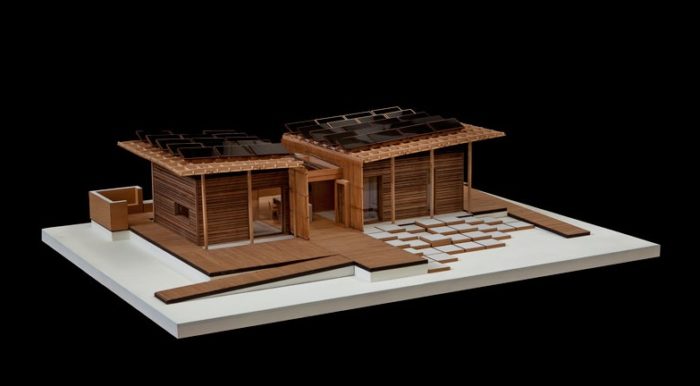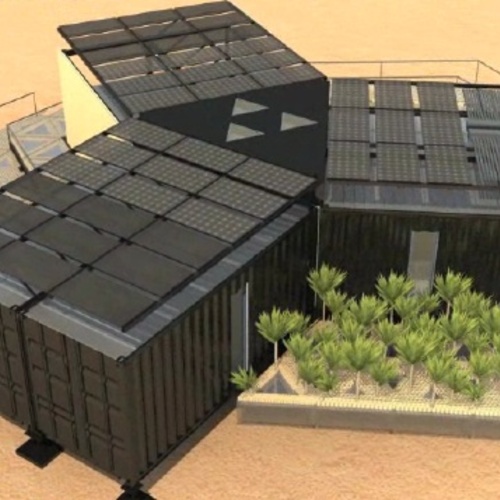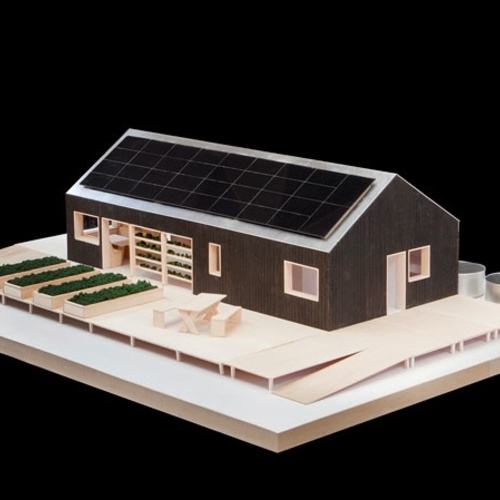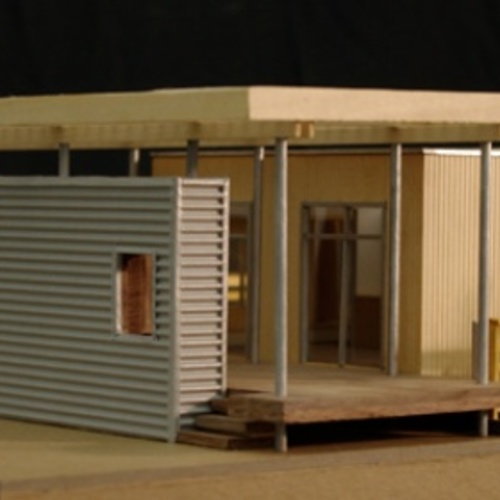
Image Credit: Victoria University, Wellington
Image Credit: Victoria University, Wellington First Light consists of two side buildings and a central section. The side buildings break up into a total of five modules for easy shipping; the central section will be flat-packed for shipping, built at an offsite location once it’s in the U.S., then shipped to the Decathlon site. First Light’s photovoltaic panels are mounted on a louvered canopy designed to provide a comfortable balance between shade and sun. First Light’s louvered solar canopy, shown here in an exploded view, is structurally separate from the shell of the house. The flat roofs of the side buildings are designed for water collection. The kitchen-and-dining area, located near the central section of the house, also opens up to the outside and can be shaded further with ceiling-mounted retractable screens. Frames for the project’s double-glazed windows, which are made by EcoWindows, based in Ragland, New Zealand.
For many New Zealanders, forging a close connection between one’s home and its environment is more than an afterthought. While that is partly because the island nation is such a beautiful place, it’s also because the New Zealand climate is generally mild and sunny. But as noted by the Solar Decathlon team representing Victoria University, Wellington, in a blog posted on the website devoted to First Light, the team’s Decathlon entry, photovoltaic (PV) systems are notably more expensive in New Zealand compared to those available in the rest of the developed world. The country has one advantage in the solar department, however: an average of 2,000 hours of sunshine each year. Although domestic hot water accounts for about a third of New Zealand’s residential energy use, only about 1.6% of homes in the country have solar hot water systems. Nevertheless, each year about 3,400 New Zealand homeowners purchase a new solar hot water system.
Live at the International Builder’s Show
The Victoria University team hopes to shed light, as it were, on the practicality of PV power by incorporating it creatively into First Light, whose open central area is flanked by two large side buildings, each of which is shaded by a louvered canopy equipped with PV panels and solar hot water collectors. Where today is tomorrow First Light takes its name not only from solar energy’s obvious role in the Decathlon, but also from the fact that New Zealand is just west of the International Date Line, which puts it among the locations on the planet that see the first light of each new calendar day – 17 to 20 hours ahead of the four time zones in the continental United States.
Follow First Light
 FACEBOOK
FACEBOOK  TWITTER
TWITTER  FLICKR
FLICKR  YOUTUBE
YOUTUBE
Get the New Zealand Solar Decathlon: The State of Solar widget and many other great free widgets at Widgetbox! Not seeing a widget? (More info)
Functionally, the Victoria team says, First Light is inspired in part by the “Kiwi bach” – a typical New Zealand vacation home whose modest size and appointments are intended to make operating and maintaining the building relatively simple. With its glass-enclosed central area – which connects the two side buildings, includes the kitchen area, and opens to the outside – First Light is also designed to be convenient and comfortable for socializing. Connecting inside and outside During an interview at the International Builders’ Show, Ben Jagersma, one of the team’s building performance specialists, told Fine Homebuilding’s Justin Fink that the two canopied, flanking buildings are “unique to our design, bringing your eye into the central space, which is the really important feature of the house.” “Life at the bach takes place as much outside, on large decks and patios, as it does inside,” the team explains on the First Light website. “Our house brings these ideals of bach life into a contemporary setting, providing a permanent residence where recreation and social activities are united with environmentally sound technologies.” The 813-sq.-ft. house, whose flat roofs underneath the canopies serve as the main sites for water collection, is being built with material from all over New Zealand, including a lot of indigenous wood (an abundant resource in that country). Construction on the project began in January – a good time to build, since it is summer in the Southern Hemisphere. For transport to the United States, Jagersma said, the two side buildings are designed to break up into a total of five modules, while the central section of the house will be flat-packed, assembled in an off-site location once it’s in the U.S., then transported to the competition site and installed between the side buildings. Asked if he thought the project would meet the $250,000 construction-cost target set for the “affordability” contest, one of 10 Decathlon competitions, Jagersma replied that his team, which includes about 40 students, believes it is “an achievable mark,” adding: “We’ve got a tradition of building quite cheaply in New Zealand.”
For an overview of the Solar Decathlon teams, see GBA’s 2011 Solar Decathlon Resource Guide
Weekly Newsletter
Get building science and energy efficiency advice, plus special offers, in your inbox.















One Comment
nice form
even though the PVs get a little funky on the roof. the diagram is great, and of all the projects posted this is the most interesting yet.
i just hope they remember to turn their building around once they get here.
Log in or create an account to post a comment.
Sign up Log in